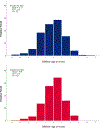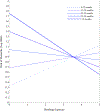Effects of war exposure on pubertal development in refugee children
- PMID: 37410441
- PMCID: PMC10527927
- DOI: 10.1037/dev0001569
Effects of war exposure on pubertal development in refugee children
Abstract
Increasing research shows pubertal development accelerates following threats while it decelerates following deprivation. Yet, these environmental stressors are unlikely to occur in isolation. We investigated how war exposure and energetic stress impact pubertal development using data from the longitudinal Biological Pathways of Risk and Resilience in Syrian Refugee Children study. Our sample included 1,600 male and female Syrian refugee children and their caregivers who lived in temporary settlements in Lebanon. We hypothesized that (a) energetic stress suppresses pubertal development; (b) war exposure accelerates pubertal timing in boys and increases risk of menarche in girls, but only when energetic stress is low; and (c) when energetic stress is elevated, effects of war exposure on pubertal development will be attenuated. Among boys, we did not find support for Hypothesis 1, but Hypotheses 2 and 3 were supported. Exposure to morbidity/mortality threats accelerated pubertal timing; this effect was attenuated under conditions of elevated energetic stress. Among girls, we found support for Hypothesis 1, but not for Hypotheses 2 and 3. Elevated energetic stress decreased the risk of menarche in girls. Neither war exposure, nor any interactions with energetic stress, predicted risk of menarche. Sensitivity analyses revealed a significant interaction between bombing exposure and the amount of time since leaving Syria. Bombing decreased the risk of menarche, but only for girls who had left Syria four or more years prior to data collection. We discuss implications for translational efforts advocating for puberty screening in medical and mental health settings to identify trauma-exposed youth. (PsycInfo Database Record (c) 2023 APA, all rights reserved).
Conflict of interest statement
Disclosures
The authors declare no competing interests or financial support.
Figures






Similar articles
-
Coming of age in war: Early life adversity, age at menarche, and mental health.Psychoneuroendocrinology. 2024 Nov;169:107153. doi: 10.1016/j.psyneuen.2024.107153. Epub 2024 Aug 3. Psychoneuroendocrinology. 2024. PMID: 39128396 Review.
-
Sexual and reproductive health of Syrian refugee adolescent girls: a qualitative study using focus group discussions in an urban setting in Lebanon.Reprod Health. 2021 Jun 24;18(1):130. doi: 10.1186/s12978-021-01178-9. Reprod Health. 2021. PMID: 34167553 Free PMC article.
-
Role of childhood adversities and environmental sensitivity in the development of post-traumatic stress disorder in war-exposed Syrian refugee children and adolescents.Br J Psychiatry. 2019 Jun;214(6):354-360. doi: 10.1192/bjp.2018.272. Epub 2019 Jan 11. Br J Psychiatry. 2019. PMID: 30630553
-
War Exposure and DNA Methylation in Syrian Refugee Children and Adolescents.JAMA Psychiatry. 2025 Feb 1;82(2):191-200. doi: 10.1001/jamapsychiatry.2024.3714. JAMA Psychiatry. 2025. PMID: 39565630
-
Prenatal and postnatal exposures to endocrine disrupting chemicals and timing of pubertal onset in girls and boys: a systematic review and meta-analysis.Hum Reprod Update. 2022 Aug 25;28(5):687-716. doi: 10.1093/humupd/dmac013. Hum Reprod Update. 2022. PMID: 35466359 Free PMC article.
Cited by
-
Coming of age in war: Early life adversity, age at menarche, and mental health.Psychoneuroendocrinology. 2024 Nov;169:107153. doi: 10.1016/j.psyneuen.2024.107153. Epub 2024 Aug 3. Psychoneuroendocrinology. 2024. PMID: 39128396 Review.
References
-
- Akresh R, Bhalotra S, Leone M, & Osili UO (2012a). War and stature: Growing up during the Nigerian civil war. American Economic Review, 102(3), 273–77.
-
- Akresh R, Verwimp P, & Bundervoet T (2011). Civil war, crop failure, and child stunting in Rwanda. Economic Development and Cultural Change, 59(4), 777–810.
-
- Angell-Andersen E, Tretli S, Bjerknes R, Forsen T, Sørensen TIA, Eriksson JG, ... & Grotmol T (2004). The association between nutritional conditions during World War II and childhood anthropometric variables in the Nordic countries. Annals of Human Biology, 31(3), 342–355. - PubMed
-
- Asparouhov T, & Muthén B (2010). Chi-square statistics with multiple imputation. Retrieved from http://statmodel.com/download/MI7.pdf on August 2, 2022.
MeSH terms
Grants and funding
LinkOut - more resources
Full Text Sources

